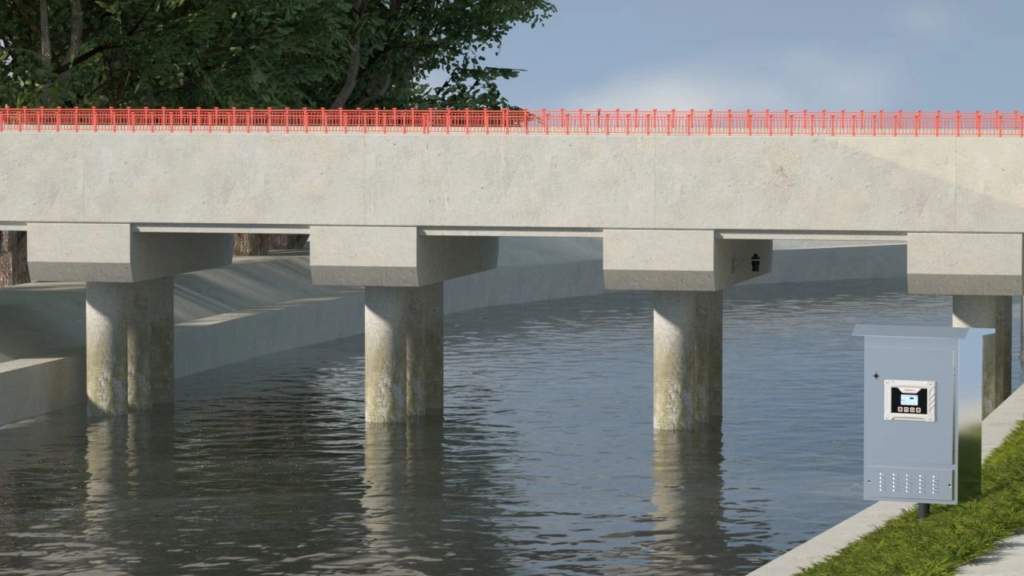(1) Water level monitoring – radar water level gauge

A large reservoir is responsible for important tasks such as flood control, irrigation, and water supply. In terms of water level monitoring, high-precision radar water level gauges are used.
Its working principle is based on microwave pulse technology. The emitted microwave pulses are reflected by the water surface and received by the radar water level gauge.
By measuring the time difference between the transmission and reception of the microwave pulses, the water level height is accurately calculated.
In practical applications, the surrounding environment of the reservoir is complex, often with severe weather such as strong winds and rainfall, and the reservoir has a large water area with a wide range of water level changes.
The radar water level gauge, with its non-contact measurement characteristics, is not affected by environmental factors such as wind, rain, temperature, and humidity, and can work stably and reliably.
Its measurement accuracy can reach ± 1mm, which can timely and accurately capture subtle changes in water level.
For example, during a heavy rainfall event, the radar water level gauge detected a rapid rise in water level in real time, with the water level rising by 0.5 meters in just 3 hours, providing accurate data support for the reservoir management department to promptly activate flood control emergency plans.
The management department adjusts the opening of the reservoir flood discharge gate reasonably based on water level data to ensure that the water level of the reservoir is always within a safe range, effectively safeguarding the safety of people’s lives and property in downstream areas.
(2) Flow monitoring – electromagnetic flowmeter

Electromagnetic flow meters are installed on the water supply pipelines and flood discharge channels of the reservoir to monitor the water flow rate.
According to Faraday’s law of electromagnetic induction, an electromagnetic flowmeter generates an induced electromotive force when a conductive liquid cuts magnetic field lines in a magnetic field.
This electromotive force is proportional to the liquid flow rate, and flow data can be obtained by measuring the induced electromotive force.
The diameter of the water supply pipeline in the reservoir is large, and the flow changes are complex. The electromagnetic flowmeter can adapt to large-diameter pipelines (some of the water supply pipelines in this reservoir have a diameter of DN2000), and has a wide measurement range, which can meet the flow monitoring needs of the reservoir under different working conditions.
During the irrigation season, by accurately measuring the water flow rate through electromagnetic flow meters, management departments can regulate the water flow rate based on the water demand of farmland, achieve scientific irrigation, and improve water resource utilization efficiency.
For example, in the past, relying on experience to estimate flow for irrigation resulted in serious water resource waste. After installing electromagnetic flow meters, precise water supply can be provided according to the actual needs of farmland.
Compared to the past, irrigation water is saved by about 20%, while ensuring the water needed for crop growth and increasing crop yields.
(3) Water quality monitoring – multi parameter water quality monitoring instrument
To ensure the water quality of reservoirs, multi parameter water quality monitoring instruments are widely used. This instrument can simultaneously monitor multiple water quality indicators such as dissolved oxygen, pH value, turbidity, and ammonia nitrogen.
Through sensor technology, real-time sensing of the content and changes in physical and chemical properties of various substances in the water body, and transmission of data to the monitoring center.
In the process of water quality monitoring in reservoirs, multi parameter water quality monitoring instruments play an important role. For example, during the high temperature period in summer, water bodies are prone to eutrophication.
The multi parameter water quality monitoring instrument real-time detects abnormal indicators of ammonia nitrogen and dissolved oxygen in the water, showing an increase in ammonia nitrogen content and a decrease in dissolved oxygen content.
Based on this, the management department determines that there may be a risk of eutrophication in the reservoir.
Subsequently, a series of measures were taken, such as strengthening the investigation of pollution sources in the incoming rivers and reducing the discharge of pollutants such as nitrogen and phosphorus;
Inject an appropriate amount of microbial agents into the reservoir to promote the decomposition of organic matter in the water and improve water quality.
Through these measures, the water quality of the reservoir gradually returned to normal, ensuring the safety of drinking water for downstream residents and the stability of the ecological environment.
